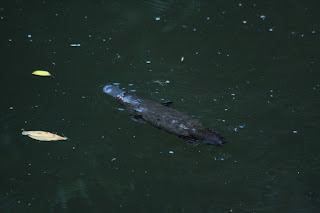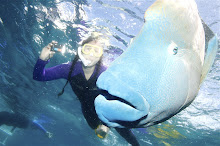
I have a couple of friends coming to Brisbane from New York later this week which has me thinking about the Qantas flight. A lot of folks don't know what to expect on their first transpacific flight so I thought I would put down some of my thoughts and recommendations. Most of this is Qantas and Australia specific, but some of it applies to other airlines and destinations. It does assume you are flying coach class. If you are flying business or first, good on you, but this list is not for you.
What do you *need* to take with you on the plane:
1)
Passport: This is kind of obvious, but it is necessary to travel overseas. Since you clear passport control before you get your luggage, it must be on your person. It is actually never a good idea to let one's passport stray far when traveling abroad.
2)
Australian Vacation Visa or ETA: This should be an electronic visa that is tied to your passport number, but it is always a good idea to carry the confirmation details with you in case there are any questions.
3) The address of where you are staying in Australia: This is required to fill out the
Incoming Passenger Card which will be presented to you to complete during the flight.
4) 14 Pounds or Less Carry-on Weight: Qantas does not allow carry-ons of more than 14 pounds. From the US you can check two bags of up to 70 pounds each, but you may not carry on more than 14 pounds. This means almost all of the large roller bags are over the weight limit. Keep your carry-ons limited to thinks you expect to need during the flight or valuables, and pack them in a small carry-on bag. A giant bag is much more likely to attract attention and be weighed than a small bag.
What other things might make the flight more enjoyable:
1) Comfortable, loose clothing for the flight: One finds that most clothing is not at all comfortable when sitting in a small seat for 12-14 hours. Sweat pants and large t-shirts are generally a good choice. Some passengers bring comfortable clothes, and change into them once the flight is under way. Shoes that can easily be slipped on and off are also a good choice.
2) Books, sudoku, magazines, etc. Qantas actually has an excellent
inflight entertainment system with a selection of on demand movies, TV, music, and basic video games of the Tetris type so I actually don't generally delve into my books much, but the entertainment system can go down so it is always good to have a backup plan.
3) A small flash light or torch: This isn't strictly necessary, but once the main lights go off, it is quite dark. You can always turn your reading light on, but in a 747 the ceiling is quite high so your reading lamp will be very bright and may disturb your sleeping neighbors so I like to have a little light that so I can search my things or read without waking up the entire section of the plane. Headlamps are great for reading. It is of course, a good idea to put the lamp somewhere where you can easily find it _before_ the lights go off.
4) A water bottle: Dehydration is a huge component of jet lag so it is important to stay as hydrated as possible on the long flight. Qantas in flight staff are good about offering passengers water, but it is always good to have your own bottle. This is tricky with the no liquids through security restriction, but you can take an empty water bottle through security and fill it on the other side or buy a new bottle at a gift stand past security.
5) Ipod or DVD player: Some people like these on the long flights, but generally I don't bother with them as their battery life is not long enough for the flight and the Qantas entertainment system offers ample entertainment. However, if you have particular entertainment requirements, they may be a good choice.
6) An extra blanket: Qantas provided everyone with a small blanket and pillow so it is not necessary, but I tend to get cold on the long flights no matter what the season so I pack and extra blanket. A sweater or comfortable jacket would also serve a similar purpose.
7) Noise Canceling Headphones: These can be pricey, but I think there are some cheaper alternatives now available. I have one of the earlier Bose full headphone models, and I highly recommend them. I wear mine to watch movies on the entertainment system and when I try to sleep. They just take away a lot of the airplane noise which is exhausting hour after hour.
Random other thoughts and tips:
1) If at all possible, get your luggage checked through to Australia from where you begin your journey. Even if you booked tickets separately, if you can show Brisbane as your finally destination, most airlines can book your luggage straight through which makes your time in LA or San Francisco less stressful. If you are on a purely Qantas or Qantas/ American flight this should be automatic, but it is always good to check.
2) 747 planes take an hour to board so boarding starts an hour prior to takeoff which means you often have a lot less time to get tickets/ go through security/ eat/ etc than you think you do. I like to have at least three hours in LA to transfer from a domestic flight to the Qantas flight and get a bite to eat.
3) If you end up with a very long layover anywhere, most of the airline clubs offer one day passes for around $50. This can offer you a quiet retreat from the noisy airport, a drink, internet access, a shower, etc. Amenities vary between clubs and locations, but when you have a ten hour layover, you have plenty of time to ask what is available at your location. I have used to American Airlines club at LAX and would do it again.
4) 747 seating is 3-4-3 which means that window seats are the most difficult to get into and out of. I love window seats for shorter flights, but I always ask for an aisle for a long haul. You will need to go to the restroom several times in 12 hours, and if you don't you aren't drinking nearly enough water.
5) Qantas carries plenty of drinking water, and they are always happy to give you some. The flight attendants normally offer water regularly, but they can become scarce when it is dark and most passengers are asleep. Do not be shy about sticking your head in the closest kitchen and asking for more water or a piece of fruit. They are happy to help you in any way that they can, and staying hydrated will help the jet lag later.
6) Generally, you leave California around midnight. In your seat you should find a blanket, pillow, and a care pouch with socks, eye mask, and toothbrush. The first three hours of the trip are taken up with takeoff, duty free sales pitches, dinner (with complimentary alcohol), arrival cards being handed out, coffee/ tea, and ice cream or hot chocolate. Once all that is done they turn the lights out with the expectation that most passengers will go to sleep or settle in with a good movie on the entertainment system. The next 6-8 hours are pretty dark and quiet though a snack packet is handed out at some point during the night. 3 hours before arrival they wake you up for breakfast and a reminder to fill out your arrival card. You generally arrive in Brisbane around 7. You lose one day going across the date line when flying west, but gain it back again when flying east.
7) The alcohol is free and you can have a reasonable amount, but alcohol is very dehydrating in a very dry environment so I don't recommend drinking too much. I generally only have one glass with dinner to relax.
8) The Qantas seats have wings on the headrests that you can bend to give your head more support. You can bend them however is most comfortable. I typically bend mine in so that my head is kind of blocked in and can't flop around.
9) If you are visiting someone in Australia, liquor is rather expensive over here so we are always happy to accept gifts of liquor from duty free :) Particularly for us Americans down under, Crown Royal, Patron, and Grey Goose are all either unavailable or prohibitively expensive.

 I booked our night's lodging at Broken River Mountain Resort which was nice, but not fancy. We stayed in the "Echidna Lodge" room type which slept three and had adequate kitchen facilities for Erik to be able to prepare a decent dinner. I believe there was a hotplate, microwave, dishes, but no oven. However, there were BBQ facilities available as well. Erik's sister and I ate at the Platypus Lodge Restaurant at the resort which was nice. The room had a shower (no tub) and a log burning stove which would be quite nice in a cooler season. There was no air conditioning, but the nights were cool even at the height of summer.
I booked our night's lodging at Broken River Mountain Resort which was nice, but not fancy. We stayed in the "Echidna Lodge" room type which slept three and had adequate kitchen facilities for Erik to be able to prepare a decent dinner. I believe there was a hotplate, microwave, dishes, but no oven. However, there were BBQ facilities available as well. Erik's sister and I ate at the Platypus Lodge Restaurant at the resort which was nice. The room had a shower (no tub) and a log burning stove which would be quite nice in a cooler season. There was no air conditioning, but the nights were cool even at the height of summer. After the thrill of seeing wild platypus for the first time, the second thrill of the visit was a complimentary night spotlighting walk. I always take any night spotlighting opportunities in Australia because 75% of Australian mammals are nocturnal so it is the only way to see many of Australia's amazing critters. The Broken River Resort spotlighting was one of the best that I have been on. We saw more platypus, sugar gliders, possums, native geckos, a tawny frogmouth, at least 4 different frog species, huntsmen spiders, luminescent fungi, and Cicadas that had just emerged from their shells and were still letting their wings dry. It was really cool! However, the guide was very enthusiastic so it also lasted a bit longer than several of the visitors' interest including Erik and his sister.
After the thrill of seeing wild platypus for the first time, the second thrill of the visit was a complimentary night spotlighting walk. I always take any night spotlighting opportunities in Australia because 75% of Australian mammals are nocturnal so it is the only way to see many of Australia's amazing critters. The Broken River Resort spotlighting was one of the best that I have been on. We saw more platypus, sugar gliders, possums, native geckos, a tawny frogmouth, at least 4 different frog species, huntsmen spiders, luminescent fungi, and Cicadas that had just emerged from their shells and were still letting their wings dry. It was really cool! However, the guide was very enthusiastic so it also lasted a bit longer than several of the visitors' interest including Erik and his sister.



























